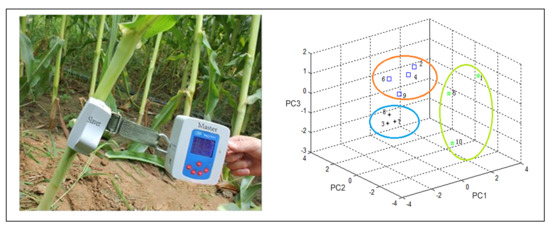Classification of Corn Stalk Lodging Resistance Using Equivalent Forces Combined with SVD Algorithm
Abstract
1. Introduction
2. Materials and Methods
2.1. Experimental Samples
2.2. Measurement of Equivalent Forces Exerted on Corn Stalks
2.3. Singular Value Decomposition Algorithm
3. Results and Discussion
3.1. The Agronomic Traits and Stalk Lodging Properties
3.2. Classification of Stalk Lodging Resistance
3.3. Comprehensive Evaluation of Different Factors Affecting Corn Stalk Lodging Resistance
4. Conclusions
Author Contributions
Funding
Acknowledgments
Conflicts of Interest
References
- Lewis, R.S.; Kernodle, S.P. A method for accelerated trait conversion in plant breeding. Theor. Appl. Genet. 2009, 118, 1499–1508. [Google Scholar] [CrossRef] [PubMed]
- Flint-Garcia, S.A. Quantitative Trait Locus Analysis of Stalk Strength in Four Maize Populations. Crop Sci. 2003, 43, 13–22. [Google Scholar] [CrossRef]
- Zhao, X.; Wang, W.; Chu, X. Early detection of Aspergillus parasiticus infection in maize kernels using near-infrared hyperspectral imaging and multivariate data analysis. Appl. Sci. 2017, 7, 90. [Google Scholar] [CrossRef]
- Robertson, D.J.; Lee, S.Y.; Julias, M. Maize stalk lodging: Flexural stiffness predicts strength. Crop Sci. 2016, 56, 1711–1718. [Google Scholar] [CrossRef]
- Huang, M.; He, C.; Zhu, Q. Maize seed variety classification using the integration of spectral and image features combined with feature transformation based on hyperspectral imaging. Appl. Sci. 2016, 6, 183. [Google Scholar] [CrossRef]
- Qiu, Z.; Chen, J.; Zhao, Y. Variety identification of single rice seed using hyperspectral imaging combined with convolutional neural network. Appl. Sci. 2018, 8, 212. [Google Scholar] [CrossRef]
- Esechie, H.A. Relationship of stalk morphology and chemical composition to lodging resistance in maize (Zea mays L.) in a rainforest zone. J. Agric. Sci. 1985, 104, 429–433. [Google Scholar] [CrossRef]
- Liu, Q.; Ma, J.; Zhao, Q. Physical Traits Related to Rice Lodging Resistance under Different Simplified-Cultivation Methods. Agron. J. 2018, 110, 127–132. [Google Scholar] [CrossRef]
- Hu, H.; Meng, Y.; Wang, H. Identifying quantitative trait loci and determining closely related stalk traits for rind penetrometer resistance in a high-oil maize population. Theor. Appl. Genet. 2012, 124, 1439–1447. [Google Scholar] [CrossRef] [PubMed]
- Allcroft, D.J.; Glasbey, C.A. Analysis of crop lodging using a latent variable model. Agric. Sci. 2003, 140, 383–393. [Google Scholar] [CrossRef]
- Berk, P.; Hocevar, M.; Stajnko, D. Development of alternative plant protection product application techniques in orchards, based on measurement sensing systems: A review. Comput. Electron. Agric. 2016, 124, 273–288. [Google Scholar] [CrossRef]
- Sharma, L.K.; Bu, H.; Franzen, D.W. Use of corn height measured with an acoustic sensor improves yield estimation with ground based active optical sensors. Comput. Electron. Agric. 2016, 124, 254–262. [Google Scholar] [CrossRef]
- Niu, L.; Feng, S.; Ru, Z. Rapid determination of single-stalk and population lodging resistance strengths and an assessment of the stem lodging wind speeds for winter wheat. Field Crop. Res. 2012, 139, 1–8. [Google Scholar] [CrossRef]
- Sterling, M.; Baker, C.J.; Berry, P.M. An experimental investigation of the lodging of wheat. Agric. For. Meteorol. 2003, 119, 149–165. [Google Scholar] [CrossRef]
- Kono, M.; Takahashi, J. The effect of wind force with reference to lodging of paddy rice. Soil Sci. Plant Nutr. 1964, 10, 20–27. [Google Scholar] [CrossRef]
- Berry, P.M.; Sterling, M.; Spink, J.H. Understanding and reducing lodging in cereals. Adv. Agron. 2004, 84, 215–269. [Google Scholar] [CrossRef]
- Sanchez, A.C.; Subudhi, P.K.; Rosenow, D.T. Mapping QTLs associated with drought resistance in sorghum (Sorghum bicolor L. Moench). Plant Mol. Biol. 2002, 48, 713–726. [Google Scholar] [CrossRef]
- Oliveira, P.C.; Moura, J.P.; Fernandes, L.F. A non-destructive method based on digital image processing for calculate the vigor and the vegetative expression of vines. Comput. Electron. Agric. 2016, 124, 289–294. [Google Scholar] [CrossRef]
- Colbert, T.R.; Darrah, L.L.; Zuber, M.S. Effect of Recurrent Selection for Stalk Crushing Strength on Agronomic Characteristics and Soluble Stalk Solids in Maize. Crop Sci. 1984, 24, 473–478. [Google Scholar] [CrossRef]
- Peiffer, J.A.; Flint-Garcia, S.A. The genetic architecture of maize stalk strength. PLoS ONE 2013, 8, e67066. [Google Scholar] [CrossRef]
- Li, K.; Yan, J.; Li, J. Genetic architecture of rind penetrometer resistance in two maize recombinant inbred line populations. BMC Plant Biol. 2014, 14, 152. [Google Scholar] [CrossRef]
- Le, H.R.; Collins, K.M.; Greaves, D.M. Mechanics and materials in the design of a buckling diaphragm wave energy converter. Mater. Des. 2015, 79, 86–93. [Google Scholar] [CrossRef]
- Butrón, A.; Malvar, R.A.; Revilla, P. Rind puncture resistance in maize: Inheritance and relationship with resistance to pink stem borer attack. Plant Breed. 2002, 121, 378–382. [Google Scholar] [CrossRef]
- Martin, S.A.; Darrah, L.L.; Hibbard, B.E. Divergent selection for rind penetrometer resistance and its effects on European corn borer damage and stalk traits in corn. Crop Sci. 2004, 44, 711–717. [Google Scholar] [CrossRef]
- Robertson, D.J.; Julias, M.; Gardunia, B.W. Corn stalk lodging: A forensic engineering approach provides insights into failure patterns and mechanisms. Crop Sci. 2015, 55, 2833–2841. [Google Scholar] [CrossRef]
- Twumasi-Afriyie, S.; Hunter, R.B. Evaluation of quantitative methods for determining stalk quality in short-season corn genotypes. Can. J. Plan. Sci. 1982, 62, 55–60. [Google Scholar] [CrossRef]
- Chen, S.F.; Danao, M.G.C.; Brown, P.J. Stalk Strength and Sugar Content of 55 Dual-Purpose Sorghum Inbreds. Appl. Eng. Agric. 2015, 31, 489–496. [Google Scholar] [CrossRef]
- Gou, L.; Huang, J.; Sun, R. Variation characteristic of stalk penetration strength of maize with different density-tolerance varieties. Trans. Chin. Soc. Agric. Eng. 2010, 26, 156–162. [Google Scholar] [CrossRef]
- Cloninger, F.D.; Zuber, M.S.; Calvert, O.H. Methods of evaluating stalk quality in corn. Phytopathology 1970, 60, 295–300. [Google Scholar] [CrossRef]
- Guo, Q.; Chen, R.; Sun, X. A Non-Destructive and Direction-Insensitive Method Using a Strain Sensor and Two Single Axis Angle Sensors for Evaluating Corn Stalk Lodging Resistance. Sensors 2018, 18, 1852. [Google Scholar] [CrossRef]
- Li, J.; Ma, Y.; Zhang, R. Principal Components Analysis and Comprehensive Evaluation of Free Amino Acids in Ripe Fruits of Different Mulberry Varieties. Food Sci. 2016, 37, 132–137. [Google Scholar] [CrossRef]
- Liu, L.; Cao, L.; Du, M. Comprehensive evaluation on yield and quality of Pinellia ternata from Sichuan based on principal component and cluster analysis. Chin. Trad. Herb. Drugs 2016, 47, 2519–2525. [Google Scholar] [CrossRef]
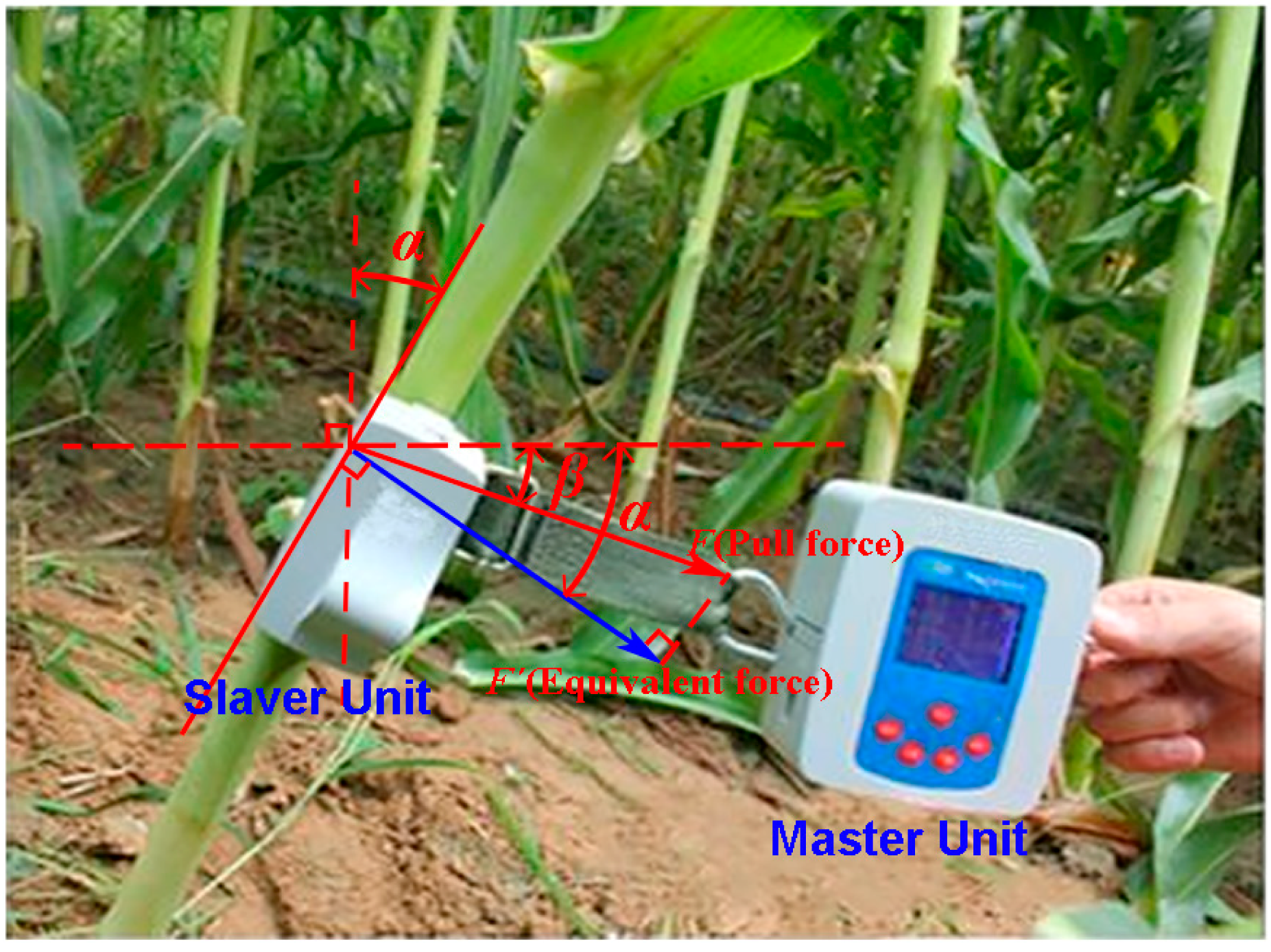
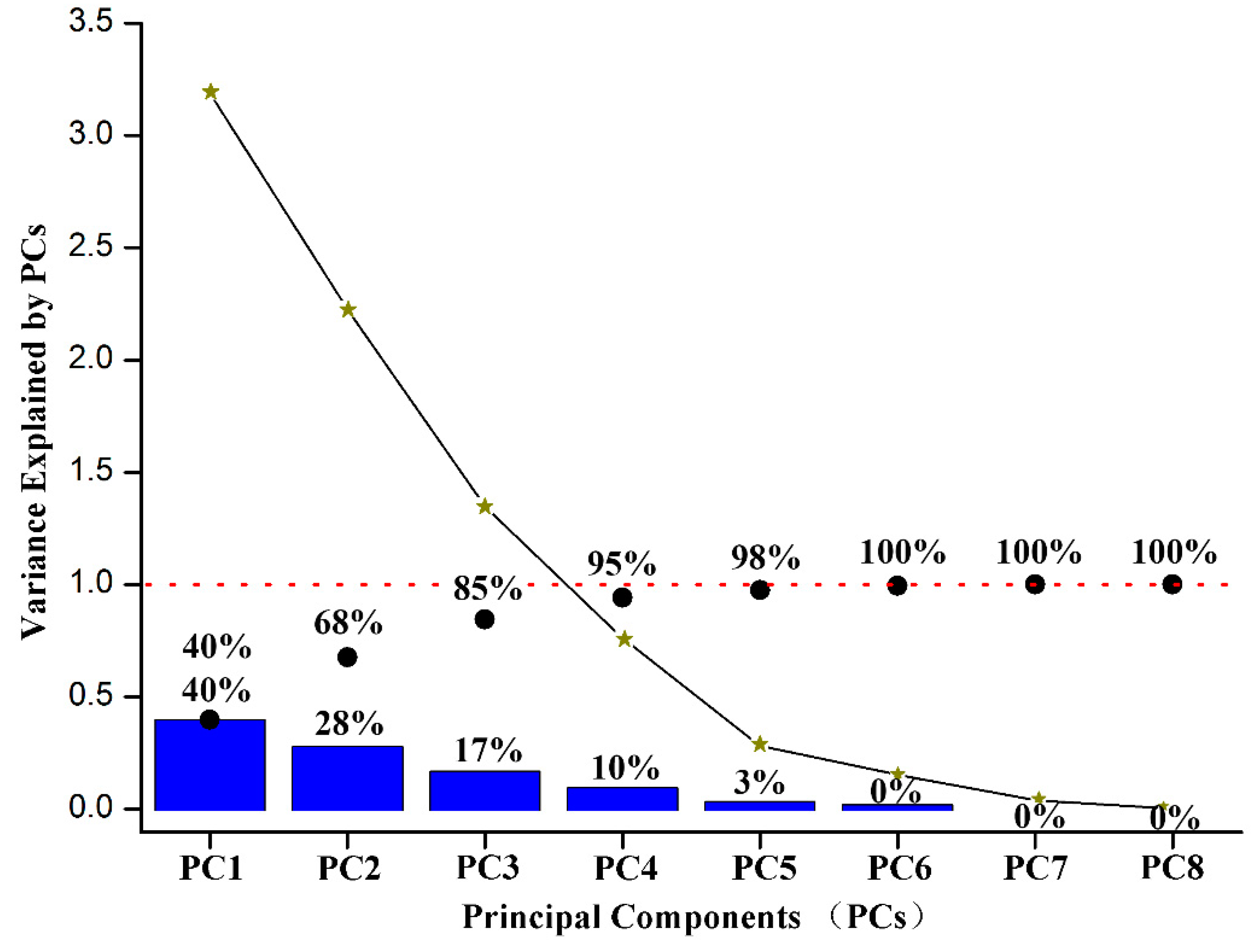
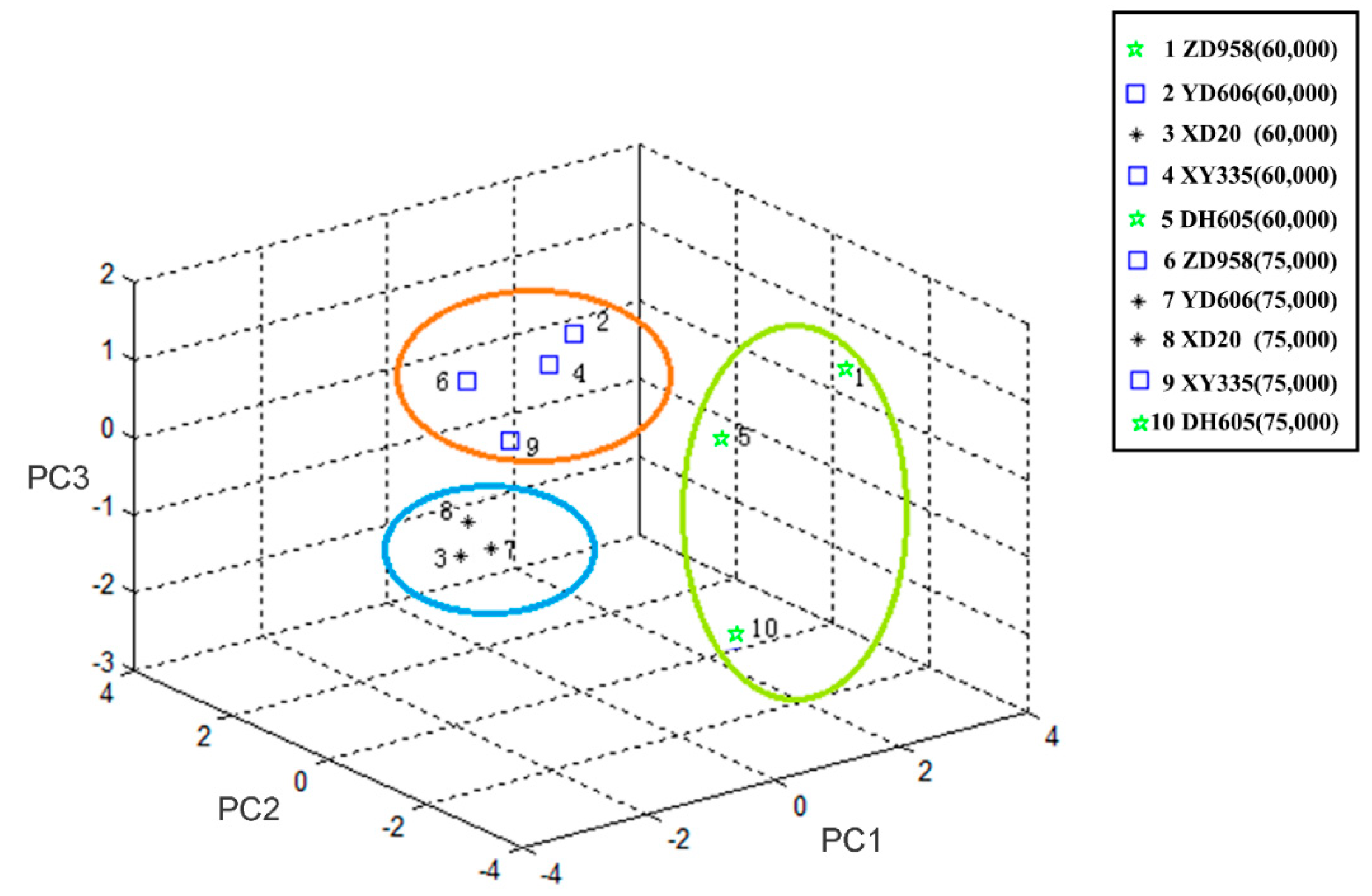
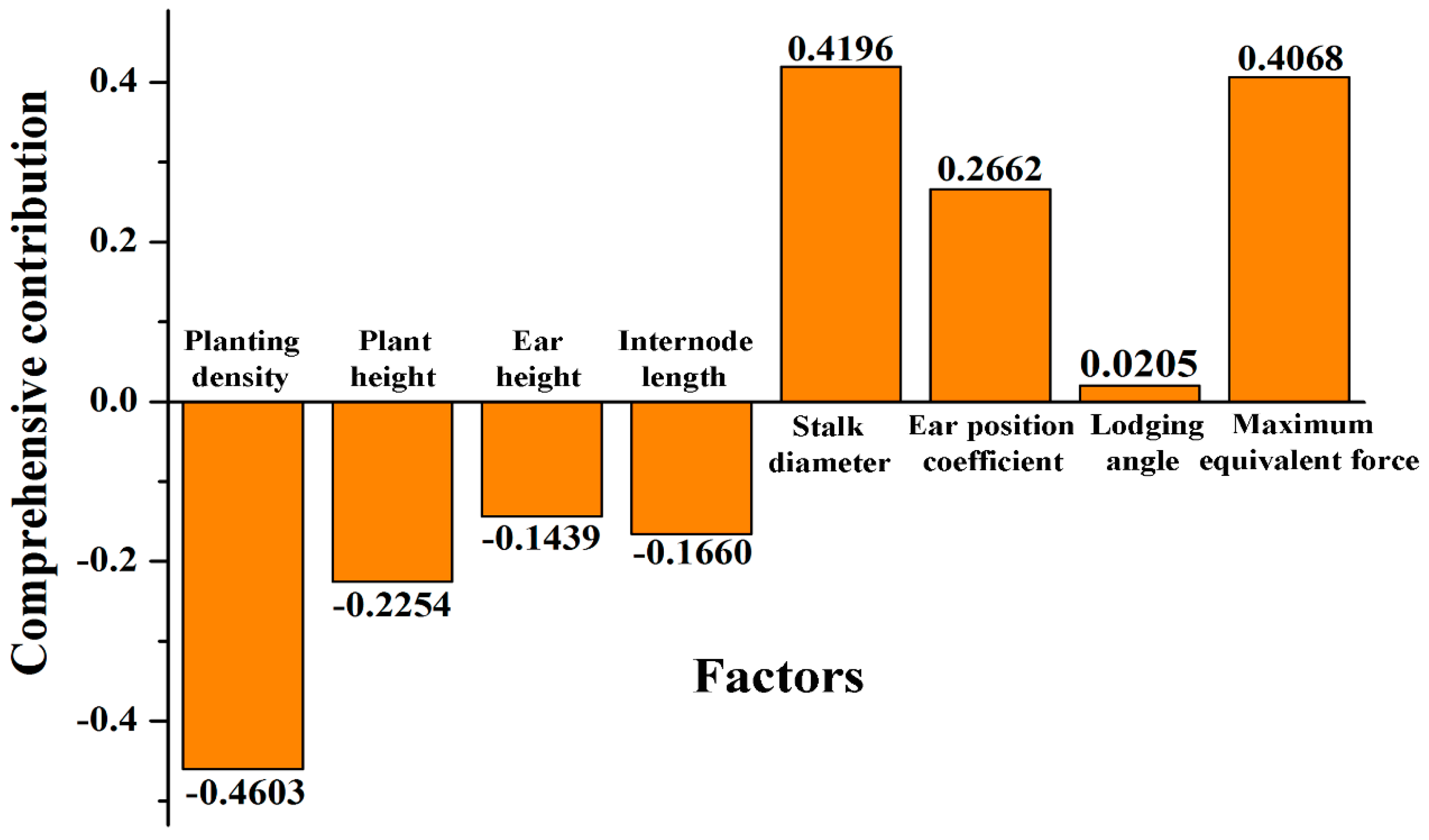
| Density (plants/ha) | Varieties | Plant Height (mm) | Ear Height (mm) | Internode Length (mm) | Stalk Diameter (mm) | Ear Position Coefficient | Lodging Angle (°) | Maximum Equivalent Force (N) |
|---|---|---|---|---|---|---|---|---|
| 60,000 | DH605 | 2510.00 b | 950.00 e | 71.00 d | 23.59 a | 0.38 c | 42.40 a | 50.76 a |
| 60,000 | XD20 | 2640.00 a | 1250.00 a | 98.10 a | 21.49 b | 0.47 a | 38.09 b | 24.79 d |
| 60,000 | XY335 | 2360.00 c | 990.00 d | 94.00 b | 20.49 c | 0.42 b | 26.50 c | 37.61 b |
| 60,000 | YD606 | 2500.00 b | 1120.00 b | 93.00 b | 20.81 d | 0.45 ab | 41.10 a | 34.50 c |
| 60,000 | ZD958 | 2500.00 b | 1000.00 c | 74.20 c | 24.09 a | 0.40 b | 40.50 ab | 38.83 b |
| 75,000 | DH605 | 2650.00 d | 995.00 e | 80.00 c | 24.21 a | 0.38 c | 37.90 a | 39.93 a |
| 75,000 | XD20 | 3020.00 a | 1340.00 a | 109.30 a | 23.51 b | 0.44 ab | 25.60 c | 26.07 d |
| 75,000 | XY335 | 2920.00 b | 1180.00 c | 111.00 a | 21.43 c | 0.40 b | 28.90 b | 38.30 a |
| 75,000 | YD606 | 2680.00 c | 1250.00 b | 95.10 b | 22.37 c | 0.47 a | 29.50 b | 34.69 c |
| 75,000 | ZD958 | 2450.00 e | 1100.00 d | 78.20 d | 24.79 a | 0.45 ab | 26.22 c | 37.50 b |
| Samples (plant/ha) | Lodging Rates Recorded in 2016 (%) | Lodging Rates Recorded in 2017 (%) | Average Lodging Rates (%) |
|---|---|---|---|
| DH605 (60,000) | 0.00 g | 0.00 f | 0.00 f |
| DH605 (75,000) | 3.18 f | 2.96 e | 3.07 e |
| ZD958 (60,000) | 7.33 e | 8.01 d | 7.67 d |
| YD606 (60,000) | 8.24 de | 8.10 d | 8.17 d |
| XY335 (60,000) | 8.23 d | 8.77 d | 8.50 d |
| ZD958 (75,000) | 9.11 d | 9.55 cd | 9.33 cd |
| XY335 (75,000) | 9.74 cd | 10.00 c | 9.87 cd |
| YD606 (75,000) | 10.11 c | 10.43 c | 10.27 c |
| XD20 (60,000) | 21.21 b | 22.13 b | 21.67 b |
| XD20 (75,000) | 31.22 a | 29.30 a | 30.26 a |
© 2019 by the authors. Licensee MDPI, Basel, Switzerland. This article is an open access article distributed under the terms and conditions of the Creative Commons Attribution (CC BY) license (http://creativecommons.org/licenses/by/4.0/).
Share and Cite
Guo, Q.; Chen, R.; Ma, L.; Sun, H.; Weng, M.; Li, S.; Hu, J. Classification of Corn Stalk Lodging Resistance Using Equivalent Forces Combined with SVD Algorithm. Appl. Sci. 2019, 9, 640. https://doi.org/10.3390/app9040640
Guo Q, Chen R, Ma L, Sun H, Weng M, Li S, Hu J. Classification of Corn Stalk Lodging Resistance Using Equivalent Forces Combined with SVD Algorithm. Applied Sciences. 2019; 9(4):640. https://doi.org/10.3390/app9040640
Chicago/Turabian StyleGuo, Qingqian, Ruipeng Chen, Liuzheng Ma, Haifeng Sun, Mengmeng Weng, Shixin Li, and Jiandong Hu. 2019. "Classification of Corn Stalk Lodging Resistance Using Equivalent Forces Combined with SVD Algorithm" Applied Sciences 9, no. 4: 640. https://doi.org/10.3390/app9040640
APA StyleGuo, Q., Chen, R., Ma, L., Sun, H., Weng, M., Li, S., & Hu, J. (2019). Classification of Corn Stalk Lodging Resistance Using Equivalent Forces Combined with SVD Algorithm. Applied Sciences, 9(4), 640. https://doi.org/10.3390/app9040640



